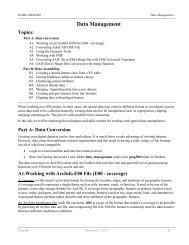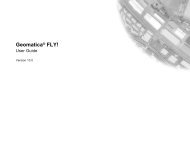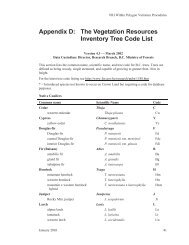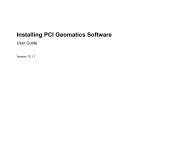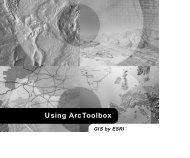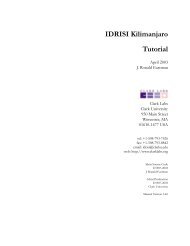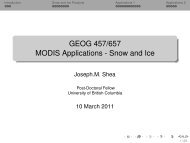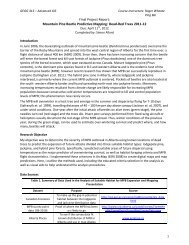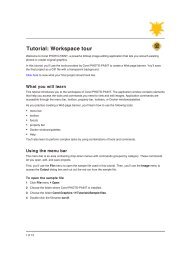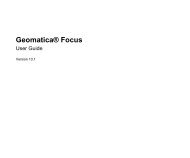Understanding Map Projections
Understanding Map Projections
Understanding Map Projections
Create successful ePaper yourself
Turn your PDF publications into a flip-book with our unique Google optimized e-Paper software.
ECKERT IV<br />
parallels. Nearer the poles, features are compressed<br />
in the north–south direction.<br />
LIMITATIONS<br />
Useful only as a world map.<br />
USES AND APPLICATIONS<br />
Thematic maps of the world such as climate.<br />
The central meridian is 0°.<br />
DESCRIPTION<br />
This equal area projection is used primarily for world<br />
maps.<br />
PROJECTION METHOD<br />
A pseudocylindrical equal-area projection.<br />
LINEAR GRATICULES<br />
Parallels are unequally spaced straight lines, closer<br />
together at the poles. Meridians are equally spaced<br />
elliptical arcs. The poles and the central meridian are<br />
straight lines half as long as the equator.<br />
PROPERTIES<br />
Shape<br />
Shapes are stretched north–south 40 percent along<br />
the equator, relative to the east–west dimension. This<br />
stretching decreases to zero at 40°30' N and S at the<br />
central meridian. Nearer the poles, features are<br />
compressed in the north–south direction.<br />
Area<br />
Equivalent.<br />
Direction<br />
Local angles are correct at the intersections of<br />
40°30' N and S with the central meridian. Direction is<br />
distorted elsewhere.<br />
Distance<br />
Scale is distorted north–south 40 percent along the<br />
equator relative to the east–west dimension. This<br />
distortion decreases to zero at 40°30' N and S at the<br />
central meridian. Scale is correct only along these<br />
50 • <strong>Understanding</strong> <strong>Map</strong> <strong>Projections</strong>




